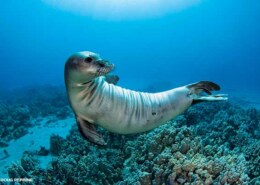Why Do Harbor Seals Swim Upside Down?
Harbour seals (Phoca vitulina), also known as the common seal, is a true seal found along temperate and Arctic marine coastlines of the Northern Hemisphere.
The most widely distributed species of pinniped (walruses, eared seals, and true seals), they are found in coastal waters of the northern Atlantic, Pacific Oceans, Baltic and North Seas.
Harbor seals are brown, silvery white, tan, or gray, with distinctive V-shaped nostrils. An adult can attain a length of 1.85 m (6.1 ft) and a mass of up to 168 kg (370 lb).
Blubber under the seal’s skin helps to maintain body temperature. Females outlive males (30–35 years versus 20–25 years).
Harbor seals stick to familiar resting spots or haulout sites, generally rocky areas (although ice, sand, and mud may also be used) where they are protected from adverse weather conditions and predation, near a foraging area.
Males may fight over mates under water and on land. Females bear a single pup after a nine-month gestation, which they care for alone.
Pups can weigh up to 16 kg (35 lb) and are able to swim and dive within hours of birth.
They develop quickly on their mothers’ fat-rich milk, and are weaned after four to six weeks.
The global population of harbor seals is 350,000–500,000, but subspecies in certain habitats are threatened.
Once a common practice, sealing is now illegal in many nations within the animal’s range.
Why Harbor Seals Swim Upside Down
Generally the eyes of many seal species are oriented toward the top of their head. Unless they are diving very deep, swimming upside down gives them a better view of their surroundings.
Jenny Montague, Assistant Curator of Marine Mammals at the New England Aquarium confirms that captive fur seals swim upside down about half the time.

This is what we call a “hunt swim” or “scanning”. Seals eyes are on the top of their heads.
When they turn over, it’s easier for them to see what’s underneath them. This posture can be helpful when hunting or for looking around the exhibit.
Harbor seals swim with all four flippers: they move their hind flippers from side to side to propel themselves forward, and use their foreflippers to help them steer.
Harbor seals can swim forward and upside–down. They rarely swim backward.
Harbor seals can dive to depths exceeding 200 m (656 ft.). They don’t routinely dive this deep, however, since most of their food is found in shallow waters.
Adult harbor seals can stay submerged for up to 30 minutes, but dives usually last only about three minutes. A two-day-old harbor seal pup can stay submerged for up to two minutes.
All marine mammals have special physiological adaptations for diving. These adaptations enable a harbor seal to conserve oxygen while it is under water.
As with other marine mammals, when a harbor seal dives, its heart rate slows – from 75 to 120 beats per minute to only four to six beats per minute. When a seal surfaces after a long dive, it experiences an accelerated heart rate for a short time.
When diving, blood is shunted away from tissues that are tolerant of low oxygen levels to the heart, lungs, and brain, where oxygen is needed.
A harbor seal has a greater volume of blood than a land mammal of similar size; therefore, it can retain more oxygen.
The muscle of harbor seals also has a high content of the oxygen-binding protein myoglobin (about 10 times as much as humans). Myoglobin stores oxygen and helps prevent muscle oxygen deficiency.
Before a deep dive, a harbor seal exhales to reduce the amount of air in its lungs. Oxygen is stored in the blood and muscle tissues, rather than in the lungs.
Habits and Lifestyle
Harbor seals are pinnipeds that are diurnal and usually solitary. They gather in small mixed groups of adult males, females, and pups during the pupping season and at the time of molting, but these groups show no social organization.
They are not a migratory species, but travel a couple of hundred kilometers from where they live to forage and breed, and sometimes to avoid environmental disturbances.
Harbor seals haul out throughout the year, that is, they come out of the sea onto terrestrial grounds on icebergs or land.
This provides the benefit of sites for birthing, rest and thermoregulation, and avoiding predators.
Harbor seals generally molt 2 to 3 months after pupping, leading to high numbers of them in haul-out locations.
The pups usually molt first, then the juveniles, then adult females, and lastly the adult males.
Credit:
http://animalia.bio/harbor-seal
https://seaworld.org/animals/all-about/harbor-seal/adaptations/



Leave an answer
You must login or register to add a new answer.